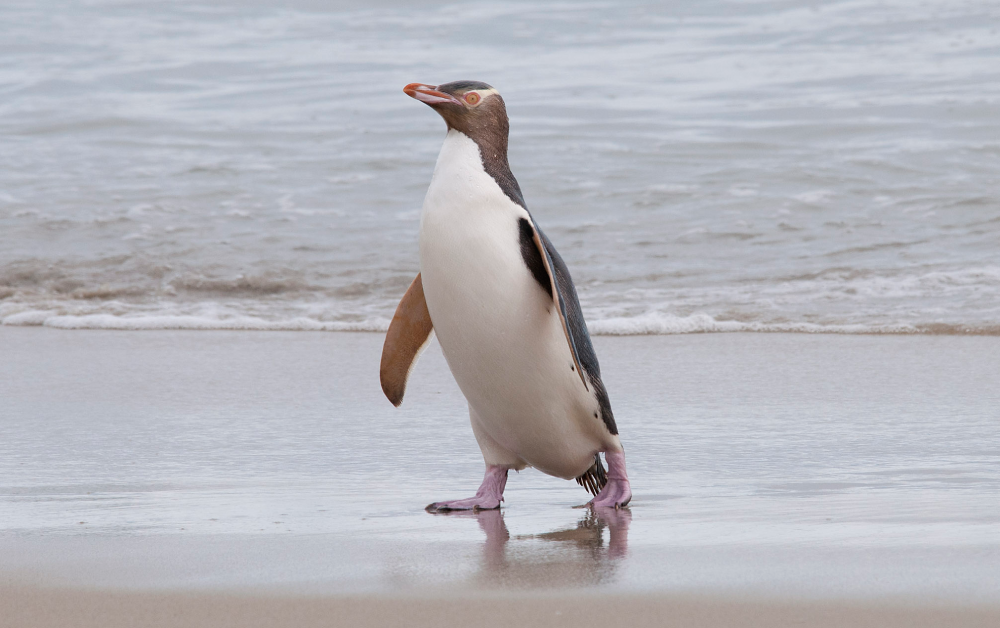Nestled along the remote coastlines of New Zealand’s South Island and some offshore islands lies a species of penguin unlike any other – the Yellow-eyed Penguin (Megadyptes antipodes). With its striking golden iris, distinctive yellow head plumage, and shy demeanor, this unique bird has captured the hearts of researchers, conservationists, and nature enthusiasts alike. However, behind its charming appearance lies a tale of struggle and perseverance, as the Yellow-eyed Penguin faces numerous challenges in its quest for survival.
Description and Habitat
The Yellow-eyed Penguin is one of the rarest and most endangered penguin species in the world. It is characterized by its vibrant yellow eyes, which are encircled by a bold band of bright yellow feathers, giving it a distinctive appearance. Adults typically stand around 60 to 70 centimeters tall and weigh between 5 to 8 kilograms, with males being slightly larger than females.
These penguins are primarily found in the coastal regions of New Zealand, particularly on the South Island and nearby subantarctic islands. They prefer rocky shorelines, coastal forests, and scrublands where they can nest and breed in relative seclusion. Unlike some other penguin species, Yellow-eyed Penguins are not social birds and often live and forage alone or in small groups.
Behavior and Diet
Yellow-eyed Penguins are primarily nocturnal hunters, venturing out to sea in the late afternoon or evening to forage for food. They feed on a variety of marine prey, including fish, squid, and crustaceans, which they catch using their sharp beaks and streamlined bodies. Unlike their Antarctic relatives, Yellow-eyed Penguins do not form large colonies and instead prefer to nest in secluded locations away from other penguin species.
Breeding and Reproduction
Breeding season for Yellow-eyed Penguins typically begins in August and lasts until February. Unlike many other penguin species that breed in large colonies, Yellow-eyed Penguins are solitary nesters, with each pair establishing its own territory for nesting. They construct their nests in dense vegetation, under overhanging rocks, or in sand dunes, using sticks, grass, and other materials.
Female Yellow-eyed Penguins usually lay two eggs, though only one chick typically survives to adulthood due to the challenges of raising multiple offspring. Both parents take turns incubating the eggs, which hatch after a period of around 39 to 51 days. Once the chick hatches, both parents take turns caring for it, feeding it regurgitated food until it is old enough to fend for itself.
Threats and Conservation Efforts
Despite their remote habitats, Yellow-eyed Penguins face numerous threats to their survival, primarily due to human activities and environmental changes. Habitat loss and degradation, caused by deforestation, coastal development, and disturbance from human activities, pose significant challenges to the species. Additionally, entanglement in fishing nets, pollution, climate change, and predation by introduced predators such as dogs, cats, and stoats further exacerbate their plight.
As a result of these threats, Yellow-eyed Penguins have experienced a significant decline in population numbers over the past century. In the 1990s, their population plummeted to dangerously low levels, prompting conservationists to take action to save the species from extinction.
Conservation efforts for Yellow-eyed Penguins have focused on a combination of habitat protection, predator control, research, and public awareness initiatives. Organizations such as the Yellow-eyed Penguin Trust and the Department of Conservation work tirelessly to monitor populations, protect nesting sites, and educate the public about the importance of conserving these iconic birds.
One of the most critical aspects of Yellow-eyed Penguin conservation is predator control, particularly on the mainland where introduced predators pose a significant threat to nesting adults and chicks. Conservationists employ various methods, including trapping, baiting, and predator-proof fencing, to reduce predation pressure and create safe nesting environments for the penguins.
Furthermore, efforts to mitigate the impacts of human activities on Yellow-eyed Penguin habitats are also underway, with initiatives aimed at minimizing disturbance from tourism, recreational activities, and coastal development. Educating local communities and visitors about the importance of respecting penguin habitats and practicing responsible behavior near nesting sites is crucial for their long-term survival.
Conclusion
The Yellow-eyed Penguin’s journey from the brink of extinction to a symbol of hope and resilience is a testament to the power of conservation efforts and public awareness. While challenges remain, dedicated individuals and organizations continue to work tirelessly to protect these charismatic birds and ensure a brighter future for them in the wild.
As we reflect on the remarkable tale of the Yellow-eyed Penguin, we are reminded of the importance of preserving our natural world and the incredible diversity of life it supports. By taking action to conserve species like the Yellow-eyed Penguin, we not only safeguard their future but also preserve a vital part of our planet’s rich tapestry of life for generations to come.










